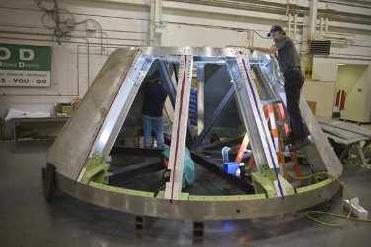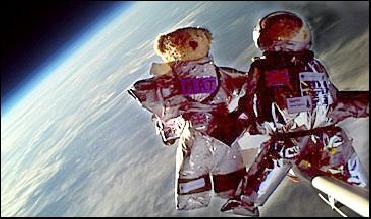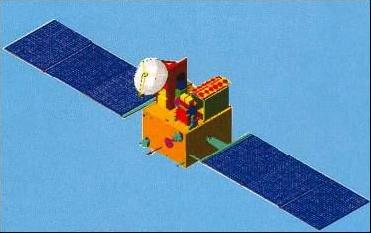
Technicians at NASA's Langley Research Center work to attach the external panels of Ares I-X crew module simulator. Photo Credit: NASA
WASHINGTON (BNS): The Ares I space transportation system, designed and developed by US space agency NASA, to send future astronauts into orbit by replacing the existing space shuttles set to retire in 2010 will begin demonstration from next year.
Ares I-X, the first Ares I test rocket, will lift off from the Kennedy Space Center, Florida in the summer of 2009. It will climb about 25 miles (40.2 km) in a two-minute powered test of Ares I first stage performance, its first stage separation and parachute recovery system, according to NASA.
The Ares I is an in-line, two-stage rocket configuration topped by the Orion crew vehicle and its launch abort system. In addition to the vehicle's primary mission -- carrying crews of four to six astronauts to Earth orbit -- Ares I may also use its 25-ton payload capacity to deliver resources and supplies to the International Space Station, or to "park" payloads in orbit for retrieval by other spacecraft bound for moon or other destinations.
Mission managers at NASA want a complete test of the rocket to assess whether the design is safe and stable in flight. This question must be answered before astronauts begin travelling into orbit and beyond, the space agency said.
Once that question is answered, the flight of Ares I-X will be an important step towards verifying analysis tools and techniques needed to further develop Ares I.
Mission managers said in order to ensure that the rocket's flight characteristics are fully understood, extreme care is being taken to precisely fabricate the rocket's simulated upper stage and the simulated Orion crew module and associated launch abort tower.
These full-scale hardware components must accurately reflect the shape and physical properties of the models used in computer analyses and wind tunnel tests in order to confidently compare flight results with preflight predictions, it said.
At NASA's Langley Research Center, Hampton, where the Orion crew module and tower-like launch abort system simulators are taking shape, researchers and managers are working to overcome multiple challenges.
Kevin Brown, project manager for the Ares I-X Crew Module/Launch Abort System (CM/LAS) project, said they were a highly matrixed team. "We have a team doing fabrication and assembly work in conjunction with an off-site screw module and launch abort tower are completed."
Jonathan Cruz, deputy project manager for Ares I-X CM/LAS, said, �This launch will prove what we got right and what we got wrong in the design and analysis phase. We have a lot of confidence, but we need those two minutes of flight data before NASA can continue to the next phase of rocket development."
According to the space agency, the Apollo Command Module should be ready to ferry astronauts to the International Space Station by 2015 and to the moon in 2020.
The completed two-part flight test article is to be delivered to Kennedy Space Centre in early 2009. Before launch, the combined crew module and launch abort system tower will be used to help demonstrate lifting, handling and stacking of Ares I-X flight test vehicle elements.
 Previous Article
Previous Article Next Article
Next Article













The Indian Air Force, in its flight trials evaluation report submitted before the Defence Ministry l..
view articleAn insight into the Medium Multi-Role Combat Aircraft competition...
view articleSky enthusiasts can now spot the International Space Station (ISS) commanded by Indian-American astr..
view article